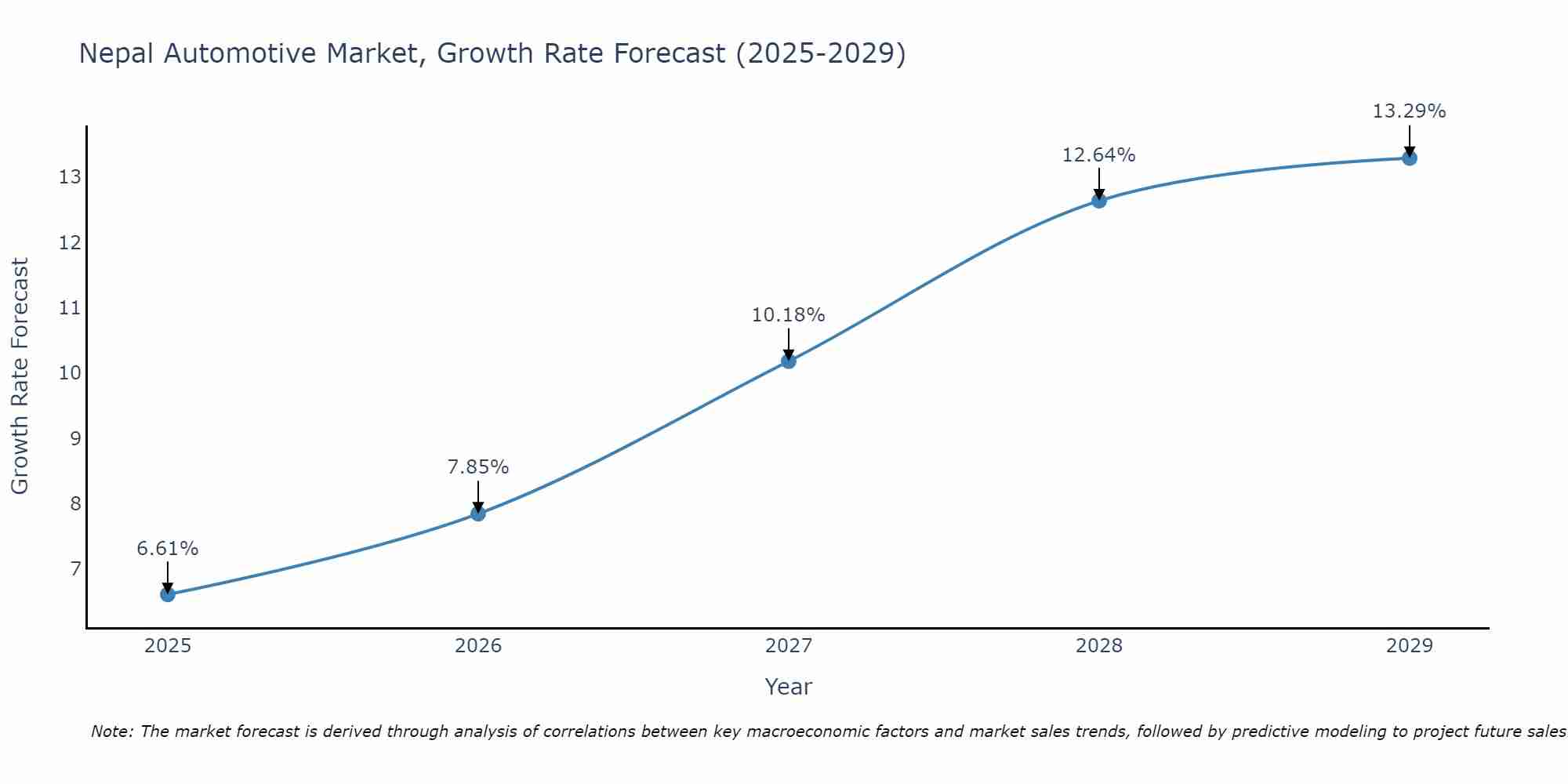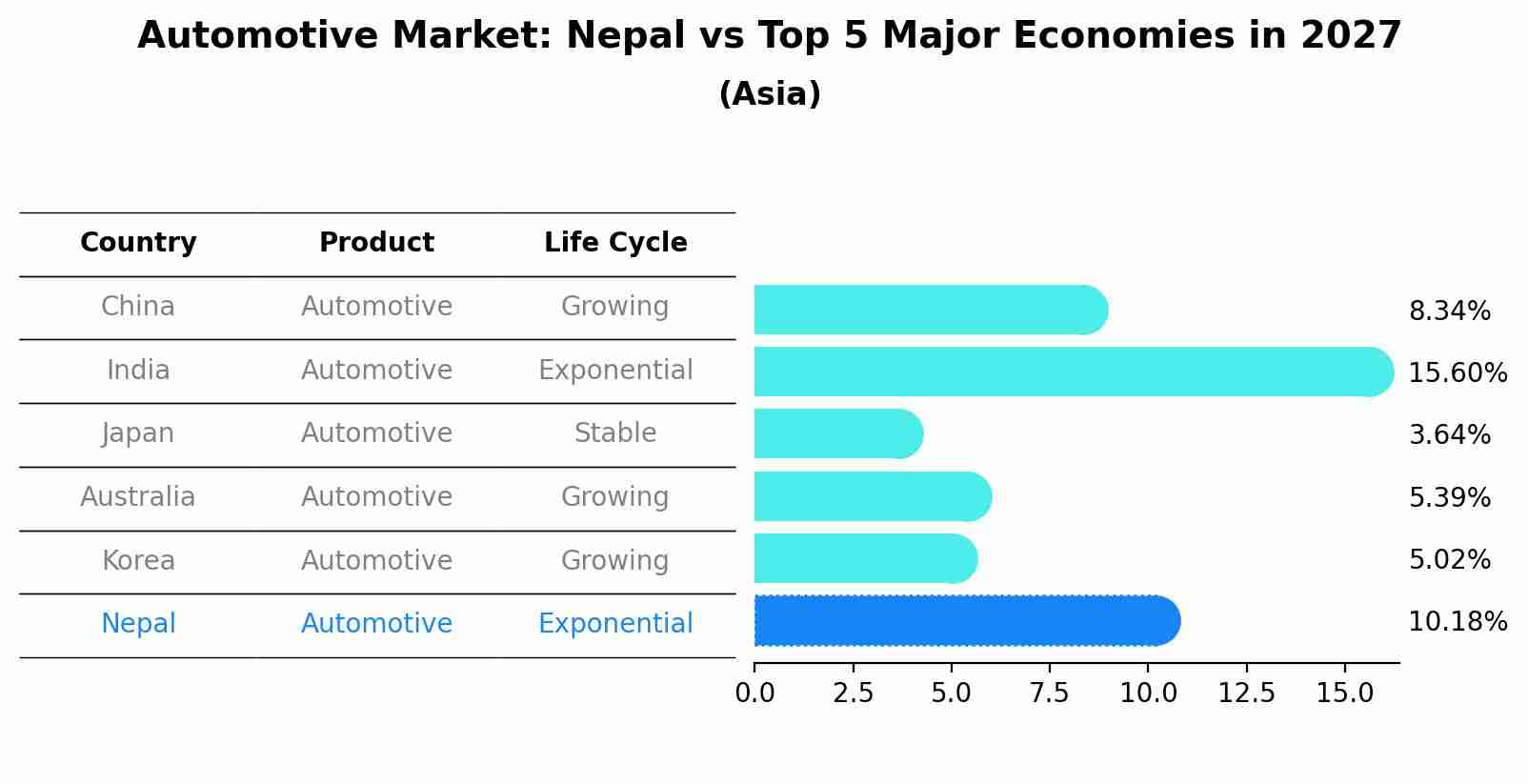Nepal Automotive Market (2025-2031) Outlook | Forecast, Value, Companies, Size, Analysis, Industry, Trends, Share, Revenue & Growth
| Product Code: ETC431792 | Publication Date: Oct 2022 | Updated Date: Jul 2025 | Product Type: Market Research Report | |
| Publisher: 6Wresearch | Author: Ravi Bhandari | No. of Pages: 75 | No. of Figures: 35 | No. of Tables: 20 |
Nepal Automotive Market Size Growth Rate
The Nepal Automotive Market is poised for steady growth rate improvements from 2025 to 2029. The growth rate starts at 6.61% in 2025 and reaches 13.29% by 2029.

Automotive Market: Nepal vs Top 5 Major Economies in 2027 (Asia)
By 2027, Nepal's Automotive market is forecasted to achieve a high growth rate of 10.18%, with China leading the Asia region, followed by India, Japan, Australia and South Korea.

Nepal Automotive Market Synopsis
The Nepal automotive market is experiencing steady growth, driven by increasing disposable income, improving road infrastructure, and growing consumer interest in vehicles. The market is primarily dominated by motorcycles and scooters, followed by cars and commercial vehicles. Japanese brands such as Honda, Yamaha, and Suzuki are popular choices among consumers. The government`s focus on promoting electric vehicles and stricter emission norms is expected to drive the adoption of electric vehicles in the coming years. However, challenges such as high import duties, limited financing options, and inadequate charging infrastructure for electric vehicles remain significant hurdles for market growth. Overall, the Nepal automotive market presents opportunities for both domestic and international manufacturers to cater to the diverse needs of consumers in the country.
Nepal Automotive Market Trends
In the Nepal Automotive Market, some current trends include a growing demand for electric vehicles (EVs) due to increasing environmental awareness and government incentives. Additionally, there is a shift towards more fuel-efficient vehicles as consumers seek to reduce fuel costs and minimize their carbon footprint. The market is also seeing an increase in the popularity of compact SUVs and crossover vehicles, driven by consumer preferences for practicality and versatility. Moreover, there is a growing interest in advanced safety features and technology in vehicles, such as autonomous emergency braking and adaptive cruise control. Overall, the Nepal Automotive Market is evolving to meet the changing preferences and priorities of consumers, with a focus on sustainability, efficiency, and innovation.
Nepal Automotive Market Challenges
The Nepal Automotive Market faces several challenges, including high import duties and taxes on vehicles, which drive up the overall cost for consumers. Additionally, the inadequate road infrastructure and poor traffic management in the country contribute to congestion and increase wear and tear on vehicles. Limited access to financing options and high interest rates also hinder the purchasing power of consumers. Furthermore, the market is heavily reliant on imports, leading to supply chain disruptions and delays, especially during times of political instability or natural disasters. The lack of stringent regulations and enforcement mechanisms for vehicle emissions and safety standards pose environmental and safety concerns. Overall, these challenges impact the growth and development of the automotive market in Nepal.
Nepal Automotive Market Investment Opportunities
The Nepal Automotive Market offers various investment opportunities due to the country`s growing middle class and increasing disposable income. Potential areas for investment include electric vehicles, as the government is promoting the adoption of EVs through incentives and policies. Additionally, there is a demand for affordable and fuel-efficient vehicles in Nepal, presenting opportunities for companies to introduce compact cars and two-wheelers. Investing in the development of infrastructure such as charging stations and service centers for electric vehicles can also be a lucrative option. Furthermore, partnerships with local dealerships and manufacturers can help international companies establish a strong presence in the market. Overall, the Nepal Automotive Market presents promising investment prospects for those looking to capitalize on the country`s evolving automotive landscape.
Jordan Agar Market Government Policies
The government of Nepal has implemented various policies to regulate and promote the automotive market in the country. These policies include the provision of tax incentives and subsidies for electric and hybrid vehicles to encourage their adoption and reduce pollution. Additionally, the government has imposed restrictions on the import of older vehicles to control emissions and improve air quality. In order to promote safety and quality standards, the government has established regulations for vehicle testing and certification. Furthermore, there are initiatives to develop infrastructure for electric vehicles, such as charging stations and battery swapping facilities. Overall, the government`s policies aim to drive sustainable growth in the automotive sector while addressing environmental concerns and promoting technological advancements.
Nepal Automotive Market Future Outlook
The future outlook for the Nepal Automotive Market appears promising, with steady growth expected in the coming years. Factors such as increasing disposable income, improving road infrastructure, and a growing population of young consumers are driving the demand for vehicles in the country. Additionally, the government`s focus on promoting electric vehicles and implementing favorable policies for automotive manufacturing and sales is likely to further boost the market. Despite challenges such as import restrictions and high taxes on vehicles, the overall trend suggests a positive trajectory for the Nepal Automotive Market, presenting opportunities for both domestic and international automotive companies to expand their presence and offerings in the market.
Key Highlights of the Report:
- Nepal Automotive Market Outlook
- Market Size of Nepal Automotive Market, 2024
- Forecast of Nepal Automotive Market, 2031
- Historical Data and Forecast of Nepal Automotive Revenues & Volume for the Period 2021 - 2031
- Nepal Automotive Market Trend Evolution
- Nepal Automotive Market Drivers and Challenges
- Nepal Automotive Price Trends
- Nepal Automotive Porter's Five Forces
- Nepal Automotive Industry Life Cycle
- Historical Data and Forecast of Nepal Automotive Market Revenues & Volume By Product Type for the Period 2021 - 2031
- Historical Data and Forecast of Nepal Automotive Market Revenues & Volume By Electric for the Period 2021 - 2031
- Historical Data and Forecast of Nepal Automotive Market Revenues & Volume By Hybrid Electric for the Period 2021 - 2031
- Historical Data and Forecast of Nepal Automotive Market Revenues & Volume By Plug-In Hybrid Electric for the Period 2021 - 2031
- Historical Data and Forecast of Nepal Automotive Market Revenues & Volume By Mild Hybrid for the Period 2021 - 2031
- Historical Data and Forecast of Nepal Automotive Market Revenues & Volume By Natural Gas for the Period 2021 - 2031
- Historical Data and Forecast of Nepal Automotive Market Revenues & Volume By Fuel Cell Electric for the Period 2021 - 2031
- Historical Data and Forecast of Nepal Automotive Market Revenues & Volume By Diesel for the Period 2021 - 2031
- Historical Data and Forecast of Nepal Electric Automotive Market Revenues & Volume By Petrol for the Period 2021 - 2031
- Nepal Automotive Import Export Trade Statistics
- Market Opportunity Assessment By Product Type
- Nepal Automotive Top Companies Market Share
- Nepal Automotive Competitive Benchmarking By Technical and Operational Parameters
- Nepal Automotive Company Profiles
- Nepal Automotive Key Strategic Recommendations
Frequently Asked Questions About the Market Study (FAQs):
- Single User License$ 1,995
- Department License$ 2,400
- Site License$ 3,120
- Global License$ 3,795
Search
Thought Leadership and Analyst Meet
Our Clients
Related Reports
- Afghanistan Rocking Chairs And Adirondack Chairs Market (2026-2032) | Size & Revenue, Competitive Landscape, Share, Segmentation, Industry, Value, Outlook, Analysis, Trends, Growth, Forecast, Companies
- Afghanistan Apparel Market (2026-2032) | Growth, Outlook, Industry, Segmentation, Forecast, Size, Companies, Trends, Value, Share, Analysis & Revenue
- Canada Oil and Gas Market (2026-2032) | Share, Segmentation, Value, Industry, Trends, Forecast, Analysis, Size & Revenue, Growth, Competitive Landscape, Outlook, Companies
- Germany Breakfast Food Market (2026-2032) | Industry, Share, Growth, Size, Companies, Value, Analysis, Revenue, Trends, Forecast & Outlook
- Australia Briquette Market (2025-2031) | Growth, Size, Revenue, Forecast, Analysis, Trends, Value, Share, Industry & Companies
- Vietnam System Integrator Market (2025-2031) | Size, Companies, Analysis, Industry, Value, Forecast, Growth, Trends, Revenue & Share
- ASEAN and Thailand Brain Health Supplements Market (2025-2031) | Strategy, Consumer Insights, Analysis, Investment Trends, Opportunities, Growth, Size, Share, Industry, Revenue, Segments, Value, Segmentation, Supply, Forecast, Restraints, Outlook, Competition, Drivers, Trends, Demand, Pricing Analysis, Competitive, Strategic Insights, Companies, Challenges
- ASEAN Bearings Market (2025-2031) | Strategy, Consumer Insights, Analysis, Investment Trends, Opportunities, Growth, Size, Share, Industry, Revenue, Segments, Value, Segmentation, Supply, Forecast, Restraints, Outlook, Competition, Drivers, Trends, Demand, Pricing Analysis, Competitive, Strategic Insights, Companies, Challenges
- Europe Flooring Market (2025-2031) | Outlook, Share, Industry, Trends, Forecast, Companies, Revenue, Size, Analysis, Growth & Value
- Saudi Arabia Manlift Market (2025-2031) | Outlook, Size, Growth, Trends, Companies, Industry, Revenue, Value, Share, Forecast & Analysis
Industry Events and Analyst Meet
Whitepaper
- Middle East & Africa Commercial Security Market Click here to view more.
- Middle East & Africa Fire Safety Systems & Equipment Market Click here to view more.
- GCC Drone Market Click here to view more.
- Middle East Lighting Fixture Market Click here to view more.
- GCC Physical & Perimeter Security Market Click here to view more.
6WResearch In News
- Doha a strategic location for EV manufacturing hub: IPA Qatar
- Demand for luxury TVs surging in the GCC, says Samsung
- Empowering Growth: The Thriving Journey of Bangladesh’s Cable Industry
- Demand for luxury TVs surging in the GCC, says Samsung
- Video call with a traditional healer? Once unthinkable, it’s now common in South Africa
- Intelligent Buildings To Smooth GCC’s Path To Net Zero


















